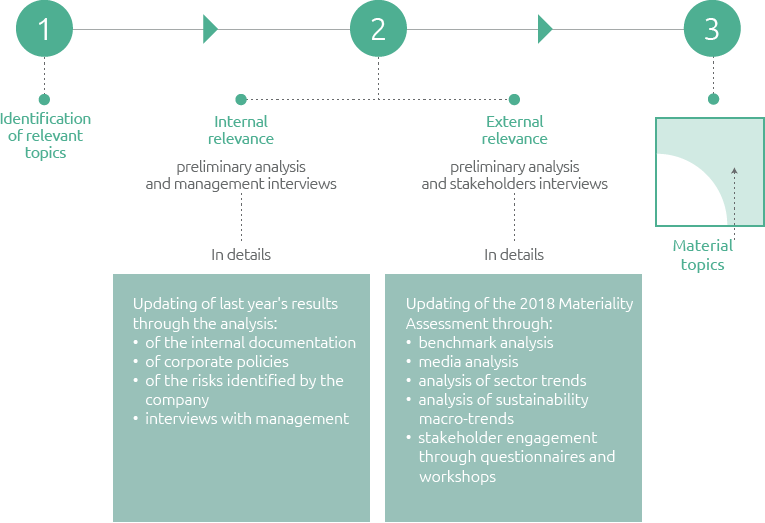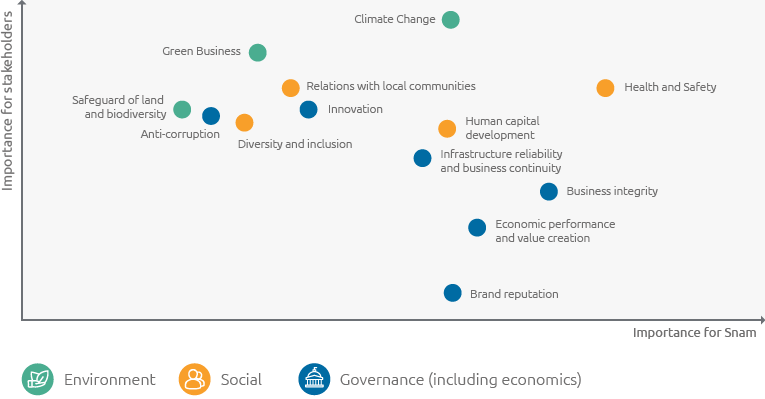The Materiality analysis

Every year Snam updates its materiality analysis in order to collect materiality issues or issues capable of reflecting the significant economic, environmental and social impacts of the company or which can substantially affect the evaluations and decisions of stakeholders.
The Global Reporting Initiative (GRI) and the International Integrated Reporting Committee (IIRC) have repeatedly proposed materiality, and the analysis thereof, as a starting point necessary to bring reporting in line with stakeholder expectations. In this sense, Directive 2014/95/EU implemented in Italy through Legislative Decree 254/2016, requires entities/companies, coming under the scope of the decree to apply this principle.
Starting with the important issues that emerged last year, Snam has updated its materiality analysis by reworking the analysis of the sustainability context and scenario and repeating the prioritisation of issues for the organisation and its stakeholders. The directions provided by the Sustainability Accounting Standards Board (SASB), for the Extractives & Minerals Processing: Oil & Gas midstream" were taken into consideration in defining the important issues.

The prioritisation of issues from the company’s perspective was carried out through interviews with the management. On the other hand, to define the most important issues from an external point of view, online surveys were conducted with all categories of stakeholders and specific workshops dedicated to employees, customers and suppliers were held. The following categories of stakeholders were considered for the online survey: Communities and local areas, Investors and lenders, Other operators, Media, Suppliers, Customers, People (Employees), Authorities and Institutions.
The involvement of Stakeholders
3 workshops organised for a total of 68 participants
5,460 online questionnaires sent with a participation rate of 39%
To get to know the point of view of its stakeholders directly, Snam conducted several workshops involving representatives from customers, suppliers and employees. During the meetings, after an introduction on Snam’s position on the issue of sustainability, this was followed by a brief induction on the concept of “materiality” and the analyses conducted to identify the relevant issues. Later on, the stakeholders were asked to validate the universe of issues and prioritise the themes by filling in a hard copy and online questionnaire. The results of the workshop, together with the preliminary analyses described above (trend, sector and benchmark), have made it possible to determine the external relevance of the sustainability issues.
This activity met with a very positive final judgement by the participants, who appreciated the involvement method and the issues discussed.
The joint analysis of the internal and external relevance led to the identification of the priority and materiality areas. The materiality matrix has been validated by the management, the ESG Committee and the CEO.
Materiality Matrix

Description of material issues

Reliability of infrastructures and business continuity
Ensuring the reliability of its infrastructures and services in order to prevent and/or mitigate potential situations that could compromise the continuity of the business (e.g. emergencies, cyber attacks).

Climate change
Promoting strategies to curb climate change, in order to reduce greenhouse gases and environmental impact, develop energy efficiency initiatives in Group plants and sites and promote a more sustainable business through the use and production of energy from renewable sources.

Diversity & Inclusion
Promoting and ensuring equal opportunities for all the employees and safeguarding diversity (race, religion, culture, gender and age) promoting dialogue and collaboration initiatives.

Business integrity
Carrying out activities fairly and correctly in compliance with the law, regulations, corporate recommendations and provisions and guaranteeing the efficiency of corporate governance, with special attention to issues of remuneration and balanced participation in the main corporate governance bodies.

Innovation
Searching for new technologies with a view to ever increasing efficiency in conducting business and reducing the impact on the environment.

Fighting corruption
Adopting preventive safeguards and targeted policies, as well as promoting partnerships that have the goal of fighting corruption and offences in general and also the dissemination of a culture of lawfulness.

Green Businesses
Integrating new businesses involved in the processes of decarbonisation in its operations supporting a low-carbon economy, such as biomethane, hydrogen, the use of gas for sustainable mobility (CNG, LNG) and new technologies capable of incorporating renewable energy from the environment.

Economic performance and creation of value
Promoting the creation of shared value in the medium-long-term for all categories of stakeholders, through operational and financial efficiency and committing to the development of business activities capable of generating value for all stakeholders.

Relations with local communities
Involving local communities in order to develop projects capable of responding effectively to the expectations of stakeholders and which also reinforce the licence to operate.

Brand reputation
Developing and protecting the brand and image through constant relations mainly with the financial community and investors (for example, disclosing transparent, exhaustive and timely information capable of representing the Company and its business).

Health and safety
Adopting management practices and systems to safeguard the health and safety of employees and third parties involved in corporate activities (e.g. suppliers).

Developing and safeguarding human capital
Encouraging professional development and attraction and retention of talent policies, enhancing the technical, managerial and organisational expertise of employees and promoting the work/life balance of staff including through welfare initiatives.

Protecting the local area and biodiversity
Protecting the landscape heritage of local areas where there are Group plants or sites and safeguarding the environment through policies for protecting the soil, subsoil and water table during operations.
The analyses described above also made it possible to identify further issues which, although not material, are, however, relevant for Snam or its stakeholders. Therefore, these issues are also monitored and overseen by the Company:
- Waste management: efficient management of waste including through the effective management of the disposal of materials used during production activities and the construction of Group infrastructures;
- Management of water resources: consumption and management of water resources in Group activities and policies and practices capable of encouraging the responsible use of water promoting reuse plans and actions;
- Employment: stable, continuous employment guaranteeing a good work environment and generational turnover in line with the development of the business;
- Relations with the authorities and quality of services: secure service, reliable over a period of time, in compliance with the principles of competition and equal treatment and access to infrastructures, as well as constructive relations with the regulatory authorities and with institutions, in order to develop satisfactory services for customers and at the same time directed at market needs and requirements;
- Supply chain: adopting policies for the selection of suppliers, contractors and partners that include the integration of sustainability criteria and the promotion of social responsibility among suppliers;
- Respect for human rights: respecting human rights throughout the value chain (suppliers, employees, customers);
- Protection of the air: initiatives aimed at reducing and curbing pollutant emissions into the air (e.g. NOx) resulting from Group operations.